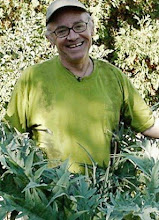 Sweet Pinks make for a bright spot in any yard.
Sweet Pinks make for a bright spot in any yard. Bumblebee food are what Chives are - I let the bees feed and then cut the flower heads off so they don't set seeds.
Bumblebee food are what Chives are - I let the bees feed and then cut the flower heads off so they don't set seeds. The next tomato job will be the straw mulch.
The next tomato job will be the straw mulch. First I rinse the seedlings in water.
First I rinse the seedlings in water. Then I tease them apart into two's or threes.
Then I tease them apart into two's or threes. And then I plant them out - later they will be thinned as bunching onion size.
And then I plant them out - later they will be thinned as bunching onion size. I planted some Japanese Daikon radishes in a cold frame to try to keep the root maggots out of them as they grow .
I planted some Japanese Daikon radishes in a cold frame to try to keep the root maggots out of them as they grow . Plus, I punched holes and filled them with potting soil to make for straighter roots.
Plus, I punched holes and filled them with potting soil to make for straighter roots. We went to the Green Bay Urban Chicken workshop this week.
We went to the Green Bay Urban Chicken workshop this week. This chicken is not full grown but what a pet - just sat there and got petted.
This chicken is not full grown but what a pet - just sat there and got petted.I went ahead and tilled and the garden was still wet in spots so I have lumps galore. However, I am off to AZ again and the work needed to get done.
My son and I drove the stakes and I strung the twine and planted the tomatoes. There are seven rows with 8 to 10 plants per row. The Nebraska Wedding plants were put at the far end because they might be determinate - one catalog says so - and they will not need as much height as the other plants. As per request of my wife I put all the Sugary's in one row right off the yard so she can get at them easily. I inter-planted two rows with my basil plants as last year basil and tomatoes did well together.
I also got the onions in. With the seed onions in flats I rinse the soil off the roots and clump plant them - thinning later to one onion per spot- hopefully. I like this method as I usually plant onions from seed and not sets. Planting sets limits the types one can get so the LaSalle and Patterson varieties are new this year. We will see how they do.
I also got most of the front flower bed and all the Zinnias planted. This summer is the year of the Zinnia so we have planted them in that honor. Besides my grandmother always had a row of zinnias in her garden - usually about 50 or 60 feet of plants so she could have cut flowers.
The tomato grafting failed miserably this spring as the last of the struggling plants died this week. I had wanted to try grafting cubits but my seedlings are just at the graft stage and as I said I must leave town for a week so I will have to start again and see what we can try.
The dames rocket is blooming and I think I am going to use that as my phenology marker for planting tomatoes in the garden. That would give me a constant to work with in the future.
Happy Gardening

A beekeeper (or apiarist) keeps honey bee life cycle in order to collect their honey and other products that the hive produce (including beeswax, propolis, flower pollen, bee pollen, and royal jelly), to pollinate crops, or to produce bees for sale to other beekeepers.
ReplyDelete